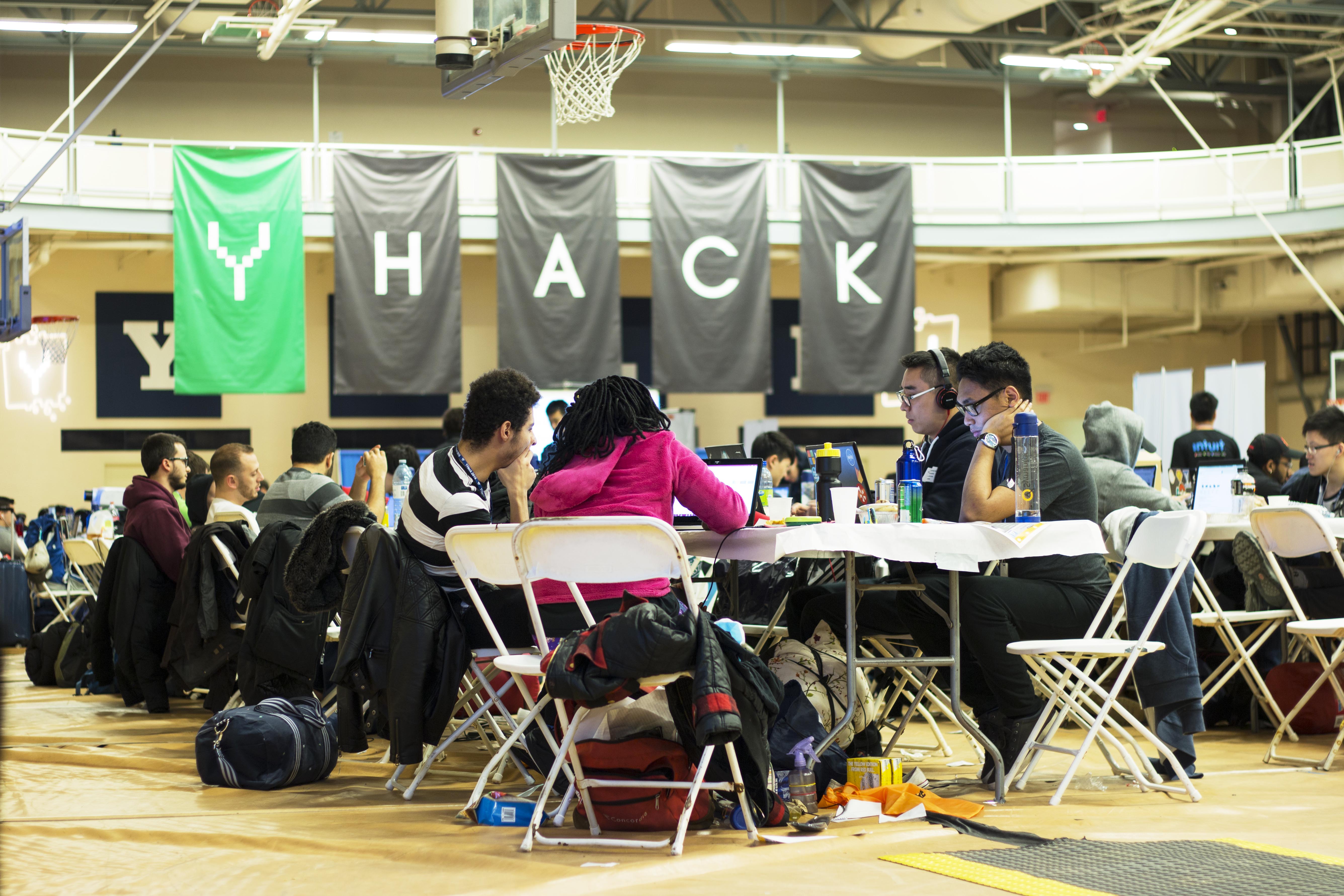
This past weekend, 1,500 hackers from across the world convened at Payne Whitney Gymnasium for the fourth iteration of YHack, an international hackathon hosted by Yale.
YHack participants, consisting of mostly students, organized themselves into groups of at most four on Friday night. They then hacked for 36 hours, from Friday at 9 p.m. to Sunday at 9 a.m., before presenting their projects to judges on Sunday morning. Overall prizes of up to $3,000 were awarded, as well as prizes from sponsor companies. The event’s sponsors include Nasdaq, T. Rowe Price — a global investment management firm — and the pharmaceutical company Merck.
According to Christopher Wan ’17, one of four directors of YHack, a hackathon is a space for people who are interested in developing mobile apps and hardware apps. Participants come together, execute their ideas and win prizes. Additionally, hackathons typically have sponsors that recruit students and provide data sets for participants to use.
“[In planning YHack], there are a lot of logistical moving parts,” Wan said. “One of the biggest things is moving around the budget and making sure that we were able to get hackers here to Yale at a cost-efficient price for us. … Figuring out how to get people from outside the east coast, like people from California, and internationally even, it’s difficult. It’s not a trivial problem to tackle.”
Wan added that planning for YHack began in May with reaching out to sponsors, some of whom were new to the hackathon. In particular, Wan said, the team focused on reaching out to sponsors who are not traditionally involved in technology, as these firms may be interested in hiring engineers.
In just 36 hours, YHack participants created a diverse set of projects that spanned multiple disciplines.
Summer Wu ’18, Ngan Vu ’19, Qingyang Chen ’17 and Harrison Pincket, a senior at Brown University, built a “smart mirror” capable of giving fashion advice. The mirror takes a photo of users, uses computer vision to detect clothing and uses color triads to figure out which colors match an outfit and recommends clothing, while also considering the weather at each user’s location.
Lilly Chen, a senior technology management major from the University of California, Davis, designed a website for Coldwell Banker, a real estate franchise. Chen described the website as a centralized location at which agents can access the resources they need, thereby solving the problem of multiple websites.
Timotius Sitorus and Mohammed Ali, students from the Stony Brook University, created a data analytics hack that analyzes insurance data to draw conclusions about the effectiveness of marketing campaigns. In designing their product, the pair used data provided by Vitech, a software provider for insurance organizations and a YHack sponsor.
“It was difficult for us because we’re not very experienced in data science. We didn’t know where to tackle the problem first, because a lot of what you have to do in data science is ask the right questions,” Sitorus said. “For a data science hack, you have to figure out your own path and your own goals. Early on, all we had was a chunk of data — and they just said go with it.”
A team of students from Binghamton University, made up of Suzanna Capric, Vladyslav Patersin, Alykhan Lalani and Tyler Popp, created a web app controller for the iRobot Roomba robot vacuum cleaner. The controller allows users to move the vacuum cleaner and receive information in real time as it interacts with its environment.
Some teams said that they were inspired by the outcome of last week’s presidential elections while designing their hack.
Jessica Josephs, a New York University junior, and Prince Channers, a senior at St. John’s University, created YHealth?, a mobile app that aims to educate users about health insurance options and motivate users to purchase coverage. The pair said that because of the uncertain future faced by affordable health care, an app like theirs is necessary to encourage individuals to get health insurance while they can.
“YHealth? helps people know what options are available, information that is normally not convenient to access, so this presents the information in a way that they are most likely to consume it: through a smartphone app,” Josephs said.
Wan said that he and the other directors — Aditya Sinha ’17, Robert Tung ’18 and Dana Lee ’17 — have several goals for YHack. First, the organizers hope students learn about software development and computer science. According to Wan, 30 percent of this year’s participants were first-time hackers. Wan added that the directors hope that more experienced hackathon participants come up with novel creations.
Wan also said that he and his team aim to promote diversity within the technology sector. According to Wan, only 20 percent of individuals employed in the industry are people of color, and less than 30 percent are women. He added that at YHack, both these proportions amounted to 40 percent and that YHack has done work to target underrepresented populations by reaching out to groups specifically for underrepresented minorities in tech.
YHack was founded in 2013.







